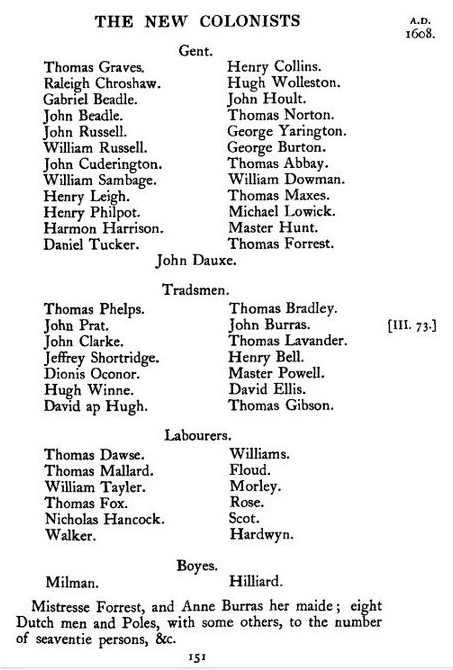Katherine Croshaw (1586-1636)
6 Children:
Thomas Graves Jr (1607-1674)
John Graves (1609-1649)
Verlinda Graves (1618-1675)
Ann Graves (1620-1683)
Frances Graves (1621-1654)
Katherine Graves (1622-1668)
Father: Thomas Graves
Mother: Joan Blagrove
Thomas Graves (1580-1635) was one of the original adventurers (stockholders) of the Virginia Company of London, and one of the very early Planters (settlers) who founded Jamestown, Virginia, the first permanent English settlement in North America. He was also the first known person named Graves in North America. Graves arrived in Virginia in October 1608 on the ship Mary and Margaret with Captain Christopher Newport's second supply. He paid 25 pounds for two shares in the London Company and thereby was entitled to 200 acres.
Thomas was born on 1 Apr 1580 at Lanbourne, Berkshire, England to Thomas Graves (1556-1637) and Joan Blagrove (1555-1637). It has been difficult to verify these parents, which names come from LDS genealogy Ancestral File submissions, but one researcher did discover that, "The will of Thomas Graves (wife Joan) (Blagrove from marriage license) with child son Thomas is extant." In about 1606, Thomas married Katherine Croshaw (1586-1636), the daughter of Capt. Rayleigh Croshaw another stockholder in the Virginia Company. Rayleigh's mother was apparently maiden name was Graves, so the two families were apparently linked even before that wedding. Katherine bore his first two sons (Thomas Jr and John) in England and brought them with her she came about 1617. That is known because a land patent granted to their son John Graves on Aug. 9, 1637 states that the 600 acres granted to him in Elizabeth City was "due in right of descent from his father Thomas Graves, who transported at his own cost himself, Katherine Graves his wife, John Graves the patentee, and Thomas Graves, Jr" (Cavaliers and Pioneers, Nugent). The 50 acres assigned for each person transported shows they came after 1616, which also fits with the birth of their first child born in Virginia, Verlinda, occurring in 1618.
The winter of 1608-09 was much better than the previous winter which had reduced the population from 105 to 38, but soon after Capt. John Smith returned to England for medical treatment in October 1609, the "Starving Time" reduced the population of about 500 to no more than 60 men, women, and children. In June of 1610, the survivors were in the process of abandoning the settlement, when Lord Delaware (Thomas West, 3rd Baron de la Warr, older brother of colonist Capt. Francis West) arrived as governor of the colony. From that time on, there was apparently no further serious thought of abandoning the town. However, even by 1616, the colony had a total population of only 351, of whom 81 were farmers or tenants.
Captain Thomas Graves settled at Smythe's Hundred, situated on the north shore of the James River ten miles from Jamestown. Governor George Yeardley placed Graves in charge of Smythe's Hundred on May 30, 1618, after one man killed another in a fight. Thomas Graves early became active in the affairs of the infant colony. On an exploring expedition he was captured by the Indians and taken to Opechancanough. Thomas Savage, who had come to Virginia with the first supply on the John and Francis in 1608, was sent to rescue him, in which he was successful.
 |
Smythe's Hundred was abandoned after the Indian uprising of 1622. The next record of Captain Graves showed him living on the Eastern Shore of Virginia by February 16, 1624.
On February 8, 1627, Capt. Francis West, Governor of Virginia, ordered that Thomas Graves have a commission to command the Plantation at Accomac. Graves was the second Commander. As an "Ancient Planter" he received one of the first patents there on March 14, 1628, consisting of 200 acres. He lived on Old Plantation Creek, now in Northampton County, Virginia, and served as Commissioner for Accomac Shire in 1629.
Captain Graves and three others represented the Eastern Shore in the Assembly of 1629-30. He served again as a burgess in 1632. Because he was designated as "Esquire" on January 6, 1635, he may have been a member of the Council.
Colonial records show that Captain Thomas Graves was entrusted with the building of the church known as Hungar's Episcopal Church on Virginia's Eastern Shore. The church may be the only English church that still holds all the original glebe lands (those granted by the English Crown). While several churches claim to be the oldest church in North America few have been holding services since 1635. It turned out that Thomas's daughter Ann married Rev. Joseph Cotton, who began to preach there in 1639.
Captain Thomas Graves, Esquire, was recorded as being a Justice at a court held for Accomac on April 13, 1635.
He died between November 1635, when he witnessed a deed, and January 5, 1635/6 (i.e. 1636), when suit was entered for Mrs. Graves concerning theft by a servant. He was survived by his wife, Katherine, and six children: John, Thomas, Ann, Verlinda, Katherine and Frances.
His daughter Verlinda married governor of Maryland, William Stone.